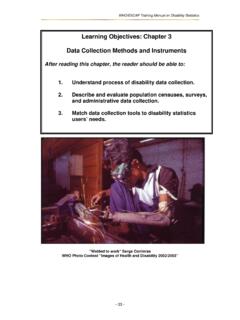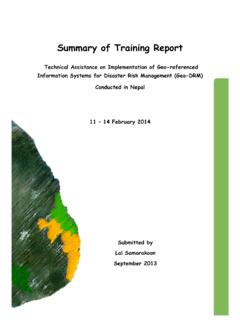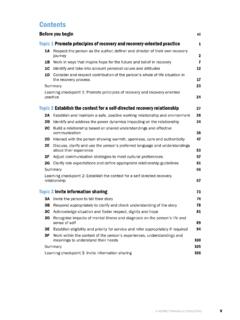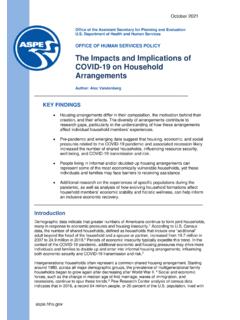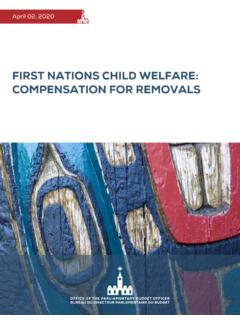Transcription of Small and Medium Enterprises Financing - ESCAP
1 Small and Medium Enterprises Financing ESCAP is the regional development arm of the United Nations and serves as the main economic and social development centre for the United Na- tions in Asia and the Pacific. Its mandate is to foster cooperation between its 53 members and 9 associate members. ESCAP provides the strategic link between global and country-level programmes and issues. It supports Governments of countries in the region in consolidating regional positions and advocates regional approach to meeting the region's unique socioeconomic chanllenges in a globalizing world. The ESCAP office is located in Bangkok, Thailand. Please visit the ESCAP website at for further information.
2 The darker area of the map represents the members and associate members of ESCAP . ACKNOWLEDGEMENTS. This paper has been prepared by Alper Aras, Regional Advisor, Macroeconomic Policy and Financing for Development Division, ESCAP . This paper benefited from comments by Tientip Subhanij and Shuvojit Banerjee. This paper is presented as a background document for the 4th High-Level Dialogue on Financing for Development in Asia and the Pacific (April 2017). The paper describes research in progress by the author(s) and are published to elicit comments and debate. The views expressed in this paper are those of the author(s) and should not necessarily be considered as reflecting the views or carrying the endorsement of the United Nations.
3 Cover credit: Shutterstock (Kzenon). This paper has been issued without formal editing. ABSTRACT. Stable access to appropriate funding sources is an important factor for the survival and growth of potential SMEs. However, most SMEs face poor access to finance in the region`s bank-dominant system. This implies that further policy support for bank loans for SME finance is needed. However, such policy support alone is not sufficient to provide long-term Financing to growth-oriented SMEs because of the nature of the banking sector`s short term credit in the region and rigid banking regulations. Furthermore, the bank-dominant system makes SMEs more vulnerable to financial shocks because these firms do not have an opportunity to diversify their funding during crises.
4 The diversification of Financing modalities beyond conventional bank lending can provide an alternative platform for the Financing needs of SMEs and expand their financial access. In this context, this paper analyzes the SME Financing landscape by examining the banking sector, nonbank financial institutions and capital market Financing for SMEs and provides policy considerations for improving access of SMEs to finance. CONTENTS. 1. Background 2. SMEs Financing Landscape Banking Sector i. Credit Guarantee Schemes and Private Credit Bureaus or Registries and Financial Statements iii. Collateral Registries Nonbank financial institutions (NBFIs). i. Micro Finance Institutions iii. Venture Capital Firms Capital Markets i.
5 SME stock markets ii. SME bond markets 3. Conclusion 1. BACKGROUND. Financial inclusion is key to the development of the Small and Medium Enterprises sector (SMEs), which is a driver of a resilient national economy in every country due to its nature of stimulating domestic demand through job creation, innovation, and competition. As of 2014, SMEs accounted for an average of 96% of all Enterprises and 62% of the national labor force in Asia and the Pacific. They also contributed an average of only 42% of the gross domestic product (GDP) or manufacturing value added in the region1. SME development is therefore critical to growth towards a more sustainable and inclusive future in the region.
6 Stable access to appropriate funding sources is an important factor for the survival and growth potential of SMEs. However, most SMEs face poor access to finance within the region`s bank dominant system. Bank loans to SMEs consist of of GDP and of total bank lending in the region, with a decreasing trend of the latter since the 2008/09 global financial crisis2. This implies that further policy support for bank loans to SME finance is needed. However, such policy support alone is not sufficient to provide long-term Financing to growth-oriented SMEs because of the nature of the banking sector`s short term credit in the region and rigid banking regulations. Furthermore, the bank dominant system makes SMEs more vulnerable to financial shocks because these firms do not have an opportunity to diversify their funding during crises.
7 The diversification of Financing modalities beyond conventional bank lending can therefore be a better alternative platform for the Financing needs of SMEs and expanding their financial accessibility. In this context, this paper analyzes the SME Financing landscape by examining the banking sector, nonbank financial institutions (NBFIs)3 and capital market Financing for SMEs to provide policy implications for improving access of SMEs to finance. 2. SME Financing LANDSCAPE. The ability of SMEs to develop, grow and be sustainable relies heavily on their capacity to access and manage finance. However, accessing the right type of finance at an affordable cost to start and grow the business is the fundamental Financing difficulty for SMEs.
8 The total credit gap4 for micro, Small , and Medium -sized Enterprises (MSMEs) was the largest in East Asia with the most number of MSMEs when compared to other regions (Figure 1). In 2014, while the total credit gap for MSMEs was $706. billion in East Asia and $206 billion in South Asia, this gap was $620 billion in Latin America and $132. billion in Sub-Saharan Africa. Furthermore, less than 15% of Asian SMEs have bank credit lines, compared to 24% in Latin America5. Thus, the average SME obtains its own capital and/or informal borrowing from friends and family members. Although SMEs relying on their own capital and with limited access to finance are better positioned to avoid serious shocks from financial and banking crises than large firms, this condition impedes the creation and development of sound and competitive SMEs, and inhibits inclusive economic growth in Asia6.
9 1. Asia SMEs Finance Monitor, ADB,2014. The Asia-Pacific group consists of Bangladesh, Cambodia, China, , Fiji, India, Indonesia, Kazakhstan, Republic of Korea, Kyrgyz Republic, Lao PDR, Malaysia, Mongolia, Myanmar, Papua New Guinea, Philippines, Solomon Islands, Sri Lanka, Tajikistan, Thailand, Viet Nam 2. Ibid 3. NBFIs include microfinance institutions (MFIs), finance companies, factoring firms, leasing firms, pawnshops, credit cooperatives, credit unions, and venture capital firms. 4. Credit gap Funding gap refers to the difference between the actual credit extended and the total credit needed by MSMEs 5. 6. A New Regime of SME Finance in Emerging Asia: Empowering Growth-Oriented SMEs to Build Resilient National Economies, Shigehiro Shinozaki, ADB, 2012.
10 The development of capital markets and NBFIs is still in the early stages in the region. For example, while NBFI Financing accounted for an average of of GDP, and represented one tenth of bank loan assets7, market capitalization of equity markets for SMEs is less than 10% of GDP8. In this context, the MSMEs Financing gap suggests the limitations of bank lending for MSMEs Financing . To overcome the constraint of bank lending for SMEs, the diversification of Financing modalities is required as an alternative channel for providing growth capital, with more sophisticated and innovative institutional arrangements needed in order to effectively meet their financial needs. However, underdeveloped capital market Financing and NBFs do not seem a realistic option for Financing SMEs in the region in the short term.
